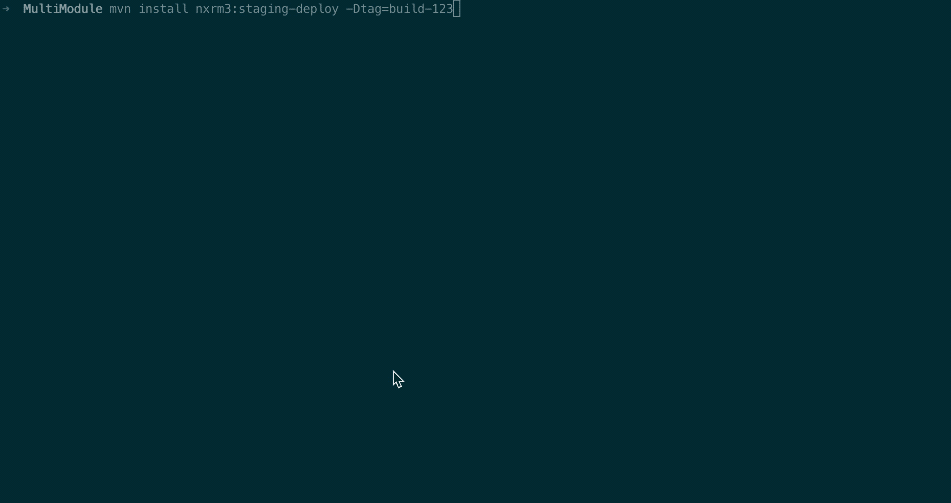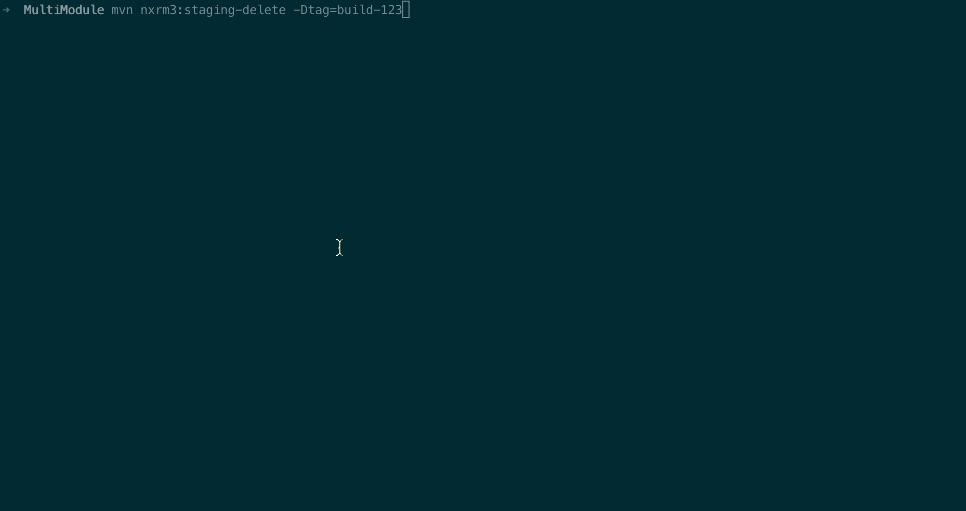Nexus Repository Maven Plugin
You can use the Nexus Repository Maven plugin for deploying, moving, and deleting packages as part of Nexus Repository's staging functionality. To use this plugin, you will need to modify your project build configuration as described in this section.
Configuration
The Nexus Repository Maven plugin replaces the Maven Deploy plugin in your build configuration and specifically enables staging actions for Nexus Repository 3.
You can configure the plugin by adding it to the project build plugins section of your project's pom.xml file as an extension:
<plugin>
<groupId>org.sonatype.plugins</groupId>
<artifactId>nxrm3-maven-plugin</artifactId>
<!-- replace plugin version with the latest available -->
<!-- https://search.maven.org/search?q=a:nxrm3-maven-plugin -->
<version>1.0.3</version>
<extensions>true</extensions>
<configuration>
<nexusUrl>http://localhost:8081</nexusUrl>
<!-- The server "id" element from settings to use authentication from settings.xml-->
<serverId>local-nexus</serverId>
<!-- Which repository to deploy to -->
<repository>maven-releases</repository>
<!-- Skip the staging deploy mojo -->
<skipNexusStagingDeployMojo>true</skipNexusStagingDeployMojo>
</configuration>
</plugin>Parameters
The Nexus Repository Maven plugin requires the following minimal configurations parameters:
serverId - The
idof theserverelement insettings.xmlfrom which the user credentials for accessing the repository manager should be retrieved.nexusUrl - The base URL at which the repository manager to be used for staging is available.
repository - The name of the repository to which the plugin is to deploy.
Maven Configurations
To successfully deploy to your repository manager, you will need to update your ~/.m2/settings.xml file with the credentials for the deploying user. To add these credentials, add the following element to the servers element in your ~/.m2/settings.xml file as shown below:
<settings>
...
<servers>
...
<server>
<id>local-nexus</id>
<username>admin</username>
<password>admin123</password>
</server>
</servers>
...
</settings>Note that the server identifier listed in Maven settings should match the serverId parameter you are passing to the Nexus Repository Maven plugin. In the example above, it contains the credentials for the default admin user. You should change this username and password to match your repository manager.
If you would like more control over when to activate the plugin's deploy goal, you have to explicitly deactivate the Maven Deploy plugin and replace the Maven Deploy plugin invocation with the NXRM3 Maven plugin shown in the example below:
<executions>
<execution>
<id>default-deploy</id>
<phase>deploy</phase>
<goals>
<goal>deploy</goal>
</goals>
</execution>
</executions>nxrm3:staging-deploy
Deploying packages using the plugin relies on assigning a tag. A tag can be generated by the plugin, assigned in the projects pom.xml, or assigned from the command line.
Note
staging.properties
When a package is sent to staging, a staging.properties file is created under ./target/nexus-staging/staging for tracking purposes. The file's contents include the name of the plugin, the date the package was staged, and the tag the package was given when staged.
You can also use this file if you accidentally staged something to perform a rollback by doing a nxrm3:staging-delete without a tag defined. The tag will be drawn from this file. See nxrm3:staging-delete for more about staging-delete.
Similarly, this file will be used to define the tag when you perform a staging-move without a defined tag. If you do not specify a tag in your move command, the plugin will use the last tag deployed.
Parameters
tag - The name of the tag to be assigned to all deployed packages.
If you do not specify a tag, one will be generated automatically in the following format:
<artifactId>-<version>-<timestamp>
For example: myproject-1.0.0-1554988263
Example Deploy
To deploy packages to Nexus Repository and assign a tag name build-123, you would enter the following from the command line:
mvn install nxrm3:staging-deploy -Dtag=build-123

To specify the tag in the pom.xml file, use the following:
<plugin>
...
<configuration>
...
<tag>build-123</tag>
...nxrm3:staging-move
Your Continuous Integration requirements may involve promoting packages. For example, this could involve moving packages from a testing repository to a production repository. The Nexus Repository Maven plugin provides this functionality.
Parameters
The required parameters for a staging move operation are as follows:
tag - name of the tag to move.
sourceRepository - the source repository from which to move packages.
destinationRepository - the destination repository to which to move packages.
As with the deploy action tag, you can assign the sourceRepository and destinationRepository in the projects pom.xml or from the command line.
Below is an example of using the plugin to move all packages deployed using the tag build-123 from the maven-releases repository to the maven-production repository.
mvn nxrm3:staging-move -Dtag=build-123 -DsourceRepository=maven-releases -DdestinationRepository=maven-production

nxrm3:staging-delete
You can also use the Nexus Repository Maven plugin to delete deployed packages. For example, if a deployment fails part-way through, requiring a rollback, you can use the plugin to delete any currently deployed packages by tag.
Warning
The delete operation will delete packages associated with the given tag across all repositories and all formats.
Parameters
tag - Delete packages associated with the given tag name.
Note
If you do not specify a tag, the plugin will default to using the last tag name that you used for a deploy operation.
Below is an example that will delete all packages associated with the tag build-123.
mvn nxrm3:staging-delete -Dtag=build-123

Customizing Tag Value Format
If you do not prefer the default tag format of ${project.artifactId}-${project.version}-${timestamp}, you can build it dynamically instead using a consistent format in POM configuration.
For example, in the POM <properties> section, define the Maven build time stamp format you want:
<!-- Build timestamp. --> <maven.build.timestamp.format>yyyyMMddHHmm</maven.build.timestamp.format>
Define a POM property that defines the complete format of the staging tag name to keep it consistent for all projects:
Perhaps re-use the project name from the pom as well:
<name>staging-test</name>
Then, define the tag name in a consistent manner in the project POM or global parent POM plugin configuration.
<plugin>
<groupId>org.sonatype.plugins</groupId>
<artifactId>nxrm3-maven-plugin</artifactId>
<version>1.0.2</version>
<extensions>true</extensions>
<executions>
<execution>
<id>default-deploy</id>
<phase>deploy</phase>
<goals>
<goal>deploy</goal>
</goals>
</execution>
</executions>
<configuration>
<nexusUrl>${nexusUrl}</nexusUrl>
<tag>${nxrm3.staging.tag}</tag>
</configuration>
</plugin>Nexus Repository 2 Users
This plugin is distinct from the Nexus Staging Maven Plugin, which only enables staging actions in Nexus Repository 2. Due to underlying architectural differences of staging between Nexus Repository 2 and Nexus Repository 3, there is no backward compatibility.